 Facebook
Facebook
 X
X
 Instagram
Instagram
 TikTok
TikTok
 Youtube
Youtube
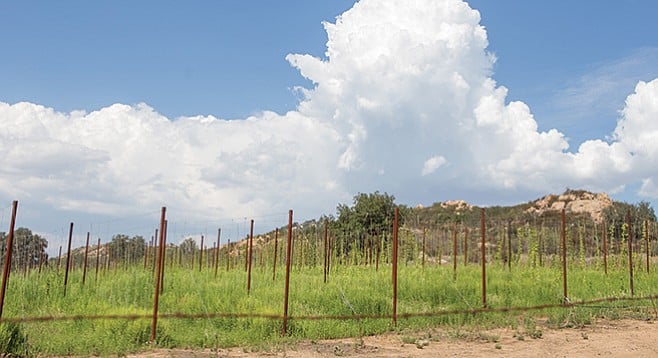
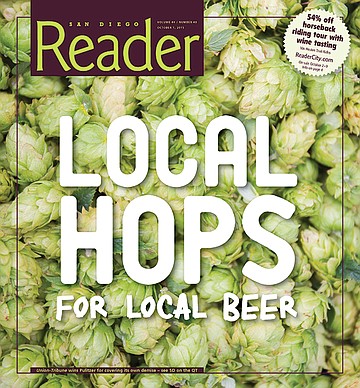
A hundred years ago, the hop-farming capital of the world was about 550 miles north of San Diego, in the Sacramento Valley. The largest farm by a long shot was the Durst Brothers Hop Yard, a 640-acre concern located in the small town of Wheatland.
If that name rings a bell for anyone, it’s thanks to the Wheatland Hop Riot of 1913. The Durst Brothers’ farm was the largest agricultural employer in all of California at the time, enlisting thousands of workers from across the state to work the summer hop harvest. In 1913, an estimated 3000 showed up for half as many jobs, and the Dursts responded to the surplus by cutting wages and refusing to provide sanitary conditions — or even water — to their pickers, despite 100-degree heat.
When the pickers attempted to organize, threatening a work stoppage, the Dursts sent in armed men to disperse their labor rally — a confrontation that led to violence and deaths on both sides. The incident proved a seminal moment for agricultural labor rights, but in its wake hop farming dried up in California.
It actually might have survived the labor crisis, but six years after the Wheatland riot, Prohibition threw a wrench in the beer market, and the state’s hop-growing dominance collapsed, dwindling to almost nothing by the 1960s, when America’s taste for beer skewed to mass-produced lagers that use minimal hops.
That landscape has changed considerably as the emergence of craft ales has created a greater demand for hops than ever before. United States hop production has grown nearly 30 percent in the past ten years alone, to reach 71 million pounds annually — a $270 million industry second only to Germany’s. As a bittering agent, hops balance out the sweetness of a beer’s malts, particularly in the case of the boldly hopped West Coast IPA (India pale ale), in which the resinous and deeply fruity flavors underlying the bitterness become the main focus of the beer itself. San Diego has made a name for itself producing this style, and many beer enthusiasts have learned to recognize the differences between hop varieties, prizing their respective nuances and complexities, even seeking them by name.
But while growing hops has once again become a huge agricultural business in this country, our state has been almost completely left out of the reemergence. According to a United States Department of Agriculture report, 78.7 percent of U.S.-grown hops hailed from the state of Washington in 2014. Oregon came in second with 11.5 percent, followed by Idaho’s 9.5 percent. California? It didn’t even rate a mention, lumped into the collective grouping of other states that comprised the remaining .3 percent.
There are good reasons for this. The climate of the Northwest better suits the way hops grow. Not just due to greater rainfall, but because hops like longer summer days and cooler winters that drive them into dormancy, when their roots gather and store the energy they need to grow spectacularly fast for two months out of the year.
Hop plants produce leafy hop cones that resemble a brussels sprout shaped like a pine cone. These cones sprout off of bines, which are similar to vines except their stems climb purposefully in a clockwise spiral, latching onto vertical surfaces with tiny threads rather than curling tendrils. In the case of a farm, the bine is usually trained up a string or rope, and in the case of farms in the Pacific Northwest they grow huge, with 25-foot tall bines producing large dense cones rich with alpha acids, the source of their bitter flavors.
The San Diego climate simply can’t compete with that. Bines grown here rarely get past 15 feet high before their cones are ready to harvest, and those cones are typically smaller and thought to contain lower ratios of alpha acids.
Despite the challenges, a new wave of local hop farmers are striving to establish a hop culture here, 500 miles south of the Sacramento Valley, which itself is considered too far south to compete with the prolific Yakima Valley farms of Washington. Perhaps more incredible is that local hops are finding a market, and actually doing so with purpose — their fresh harvests fulfilling a particular niche of increasing value to craft brewers: wet-hop beers.
Lyle Kafader, cofounder of the nascent San Diego Hop Growers Association, says there are at least 13 currently active local farms. Like Kafader’s ZP Growers property in Fallbrook, most are quite small, growing a few dozen plants that produce only 50–100 pounds per year.
To give an idea how far that goes, a typical IPA might use three pounds per barrel. Some of the more extreme double and triple IPAs out there may add as many as eight pounds or more. So, a single microbrewery working on a 30-barrel system could single-handedly consume the entire annual crop of one of these smaller farms in a day. With more than 100 breweries buying hops in San Diego County, it becomes clear that we are far from a scenario in which local hop harvests are robust enough to support local production.
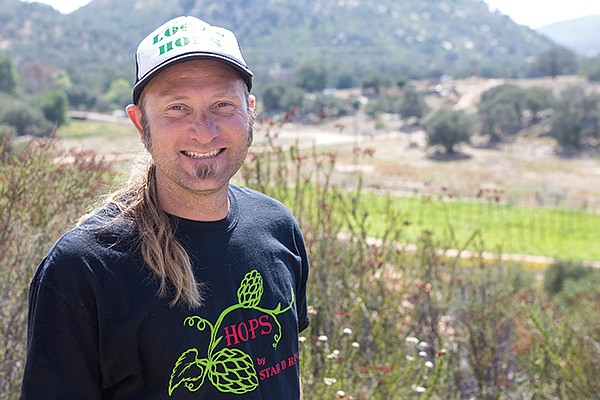
However, some larger farms have begun to produce slightly more commercially viable quantities. San Diego Hops Growers Association cofounder Eric March is entering his sixth harvest with the hop yard at the Star B Ranch in Ramona. The ranch has primarily been in the business of raising buffalo over the past three decades, and while hops occupy only 2 of the Star B’s 1200 acres, it still rates among the largest and the oldest hop farms in the county.
March used to work in fabrication and construction and had no farming background whatsoever. He initially got involved at Star B to help his wife’s family rebuild following the Witch Creek fire of 2007. March says the family wanted to diversify and took a long look at following the model of neighboring properties in the San Pasqual Valley by starting a vineyard. However, after a few days spent touring wineries and exploring the practical side of viticulture, when the family gathered for dinner to discuss what they’d learned, it became clear another crop might be better attuned to their interests. “At the end of the day,” March says, “everybody would order a beer.”
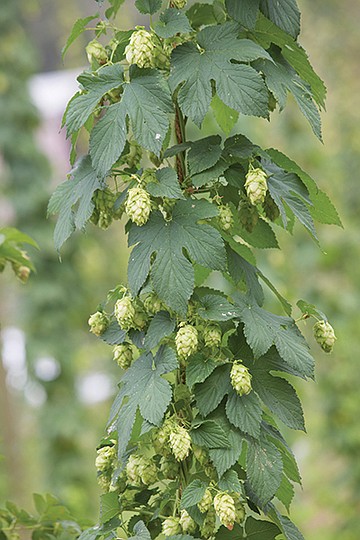
When he planted Star B’s first hop bines, the plan was to start a brewery at the ranch that would make fresh beer on site with homegrown hop cones. But he says due to zoning laws, “San Diego County told us we couldn’t make beer on agricultural land.”
That might have put an end to it, but the beer industry was growing in leaps and bounds at the time, and the rising popularity of IPAs resulted in hops demand far exceeding supply. So, March says, Star B went ahead with the hop-farm idea: “We decided to see if we could help alleviate the shortage.”
Today, Star B raises nearly 3000 plants covering a wide range of varietals, mostly Cascade, Nugget, Crystal, and Chinook. March started out planting 12 varieties, “to figure out which ones perform when it’s hot and dry,” and while he still tries growing small amounts of other types, he cites these as the best performers in our climate.
Other hop farms around the county confirm that those four hop varieties seem to grow best in the SoCal environment, along with lesser-known varieties Zeus and Galena. Nopalito Farm & Hopyard in Valley Center raises about 2000 plants covering all six varietals. Owner Jordan Brownwood says hop plants don’t really produce a lot of flowers their first two harvests — “The third year is when they really start to produce.” So, the 500 new plants he and his wife Mariah planted last winter didn’t contribute much toward their anticipated 1200–1500 pound harvest this August.
The Brownwoods are the county’s newest hop farmers, having bought the seven-acre, certified organic farm in January. Mariah Brownwood says the property held a lemon orchard for many years, then grew avocados for a time. And while some of those trees remain, she and her husband have increased their hop-growing area to between two and three acres, seeking to increase the annual harvest going forward, both in terms of the varieties they grow and the weight of their annual yield.
“If we can get 3 or 4 pounds of fresh hops out of each plant, that’s a good yield for down in San Diego,” Jordan says. “The massive commercial hop yards up in Washington will get 20 pounds off a single plant.”
Some of that difference has to do with growing practices, but a lot of it has to do with longer days at higher latitudes during the plant’s peak growing time in early summer.
“Hops typically are grown in more northern latitudes because they like long days,” Jordan points out, “The way we get around longer days is, it’s really sunny here.” After some consideration he adds, “It doesn’t truly even out but it gets us close.” Once they’ve made it through their first harvest, the Brownwoods plan to have their hops tested to see how the alpha acids compare to those from Yakima Valley, the undisputed hop capital of the US.
In the meantime, Jordan and Mariah have their work cut out for them. They don’t live at Nopalito. They commute three or four times a week from Golden Hill. Sometimes they camp overnight between days working their land. In addition to farming, they own and operate the Royale with Cheese food concession at University Heights bar Park & Rec, Jordan bartends, and Mariah works in event planning. Mariah says they wanted to start farming because, “We wanted to buy land and do our own thing.”
Though fans of craft beer, the Brownwoods didn’t realize hops were grown commercially in the region till they met Lyle Kafader of ZP Growers. Kafader initially bought the Valley Center acreage in 2010 to expand on her small Fallbrook hop yard. She planted hops and took the property through the organic certification process but says she ultimately decided to sell to the Brownwoods because the project “Got to be too big.” Because if there’s anything to be learned from those thousands of mistreated workers in Wheatland, hop farming is a labor-intensive task.
“It is a lot of work,” says Corie Johndro, “and not as lucrative as a lot of other crops. So I don’t know that I would encourage people to necessarily do it.”
Johndro and her husband Gary own the 1.5-acre San Diego Golden Hop Farm in Fallbrook with around 1200 plants. They used their drought-reduced 2014 harvest as a learning experience more than commercial enterprise. They hosted harvest parties with friends and home brewers and gained an appreciation for the amount of care and attention hops require in order to grow them fruitfully.
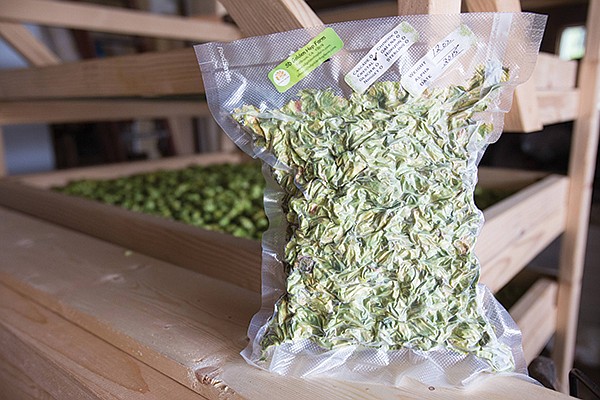
“We really baby each plant,” says Corie. “We really take our time. We trim them all up…. We’re trying to get the energy to focus and concentrate on the bine.”
“We’re doing it by the book,” adds Gary, a homebrewer who also used some of the homegrown hops in the making of his own beer.
In a way, the craft-brewing industry brought the Johndros to San Diego. After 20 years living in Santa Barbara, they shut down their manufacturing business and moved here to be closer to their daughters, one of whom has spent several years working for beer companies.
When the Johndros bought their land in 2013, it had been vacant for more than a year and was littered with avocado-tree stumps. “Most of Fallbrook was avocados at one time,” Corie explains. “When the economy got bad…people just cut them down because they take so much water. So, you’ll drive around and see stumps everywhere.”
They removed the stumps and decided, as Gary puts it, “Hops might be a fun thing to try.” As they’d later learn, the fun involved three people working eight to ten hours a day, six to eight months of the year, to produce about a pound of hops per plant. They expect a larger yield this year and next, as the plants mature. But they don’t see it ever becoming a major cash crop.
“It grows wild in other parts of the world, so people call it a weed,” Corie says. “We laugh and call it ‘the other weed’ — the one that doesn’t make as much money.”
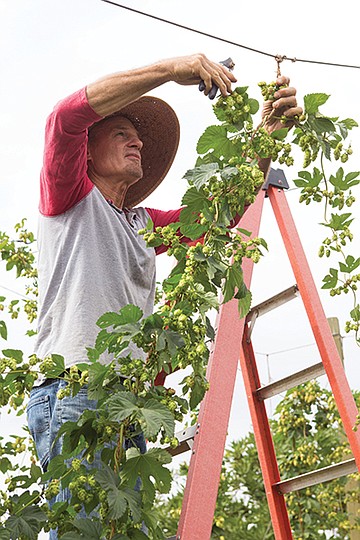
Golden Hop Farm carries a “Naturally Grown” certification, which probably limits its yield, but the Johndros considered themselves dedicated locavores who’ve long grown their own produce and practiced organic principles.
Most of San Diego’s hop farmers use “sustainable” methods — not always easy with water concerns, especially during the six to eight weeks each summer that hop bines come out of their winter dormancy to drink and sun and grow and flower. “A hop bine literally grows eight to ten inches a night,” says Gary Johndro, “It takes in energy all day and then it just shoots up.”
While hops consume far less water than avocado trees, they’re still a thirsty plant in the summertime, making it tricky for farmers to comply with the state’s 15 percent reduction mandate and still turn out a productive crop.
“Last year was a ballbreaker for everybody,” says Zack Summers, who owns Hopatul Farms, located east of Alpine in the Japatul Valley. “Last year the drought hurt everybody’s production.”
Hopatul runs on well water, so he’s not compelled to fall within the state’s rationing guidelines, but like the other farmers, he needs to monitor water usage closely and uses drip irrigation.
Summers was one of the original owners of El Cajon craft-beer hub Main Tap Tavern, which contributed to his interest in growing hops on his East County property — 200 plants going on 300. “I just wanted to be in a different aspect of the industry,” he tells me, adding that “Being in that industry, I know a lot of people that I could potentially sell to.” He already counts Coronado Brewing, Ballast Point, and Mike Hess as customers.
What impels these guys to buy local hops? Craft brewers notoriously buy hop futures, locking in contracts with high-volume growers for three to as many as seven years to ensure they have continued access to the hops they need to ensure the taste of their most successful beers remains consistent. In a good year, if all the San Diego Hop Farms squeezed an optimal harvest out of all their plants, they might produce a collective 30,000 pounds and gross a generous $150,000 — if they sold above the $3.83/pound average market value.
Compare that to the 56 million pounds and $220 million of Washington, and one wonders why San Diego hop farmers should bother. They would really need to offer something of value that brewers can’t get from Washington.
They do: same-day delivery of freshly harvested hop cones.
Fresh, often called “wet” hops, are crucial for brewing beers boasting added levels of flavor and freshness thanks to the use of whole cone hops harvested on the same day the beer is brewed.
The majority of all beers use hop pellets. The hop cones are dried and kilned, then molded into pill-shaped pellets that brewers use to dose their malts. These pellets, and even dried whole cones, may be used year round. They’re easy to transport and maintain their flavors for a long time.
Like any freshly harvested fruit or vegetable, wet hops offer more vibrant flavor and aroma, which they rapidly lose after as little as a day. Like a meal prepared with picked-that-morning produce, beer brewed with wet hops may possess greener, zestier flavors. Depending on the hop varieties used, a wet-hop beer may taste fruitier, pinier and/or spicier than the same beer made using hop pellets.
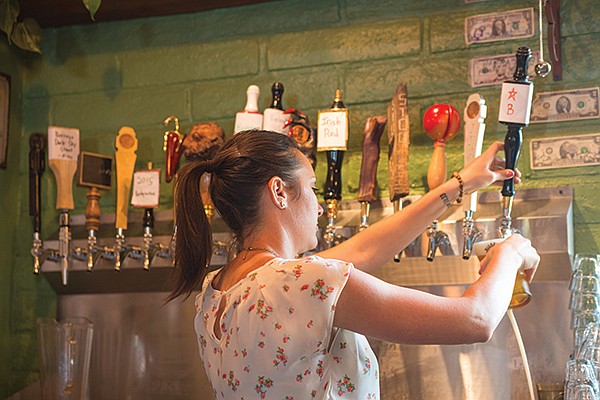
“The wet-hop beers are kind of unique,” says Tom Nickel. “They just add different flavors to the beer.” Nickel is San Diego’s greatest champion of wet-hop beers and has almost singlehandedly established a market for fresh, locally grown hops.
The award-winning brewer has a deep history within the San Diego beer scene. He worked for the Home Brew Mart that spawned Ballast Point. He brewed for Pizza Port and Oggi’s prior to starting his own Nickel Beer Company. In 2003, he bought O’Brien’s Pub, the city’s seminal craft-beer taphouse, and in October of that year hosted the first Wet Hop Beer Festival — an annual event during which the Kearny Mesa bar’s tap list focuses on some of the season’s finest wet-hop beers.
“When it started, most of the wet-hop beers came from somewhere else,” Nickel says, citing Oregon’s Rogue Ales and Northern California’s Sierra Nevada as examples. Sierra Nevada’s Harvest is usually credited as the first wet-hop beer made in the U.S., debuting in 1996, around the time San Diego’s craft scene was just getting started. That’s the first Nickel tried, and he’s been a fan since.
“It makes it really easy to brew excellent beers with those hops,” he says. His first attempt at brewing with them dates to 2000, working alongside Tomme Arthur, who is better known as the brewer behind the Lost Abbey microbrewery in San Marcos. “Tomme and I were probably the first people in town brewing them,” he recalls. “We were getting them through Hop Union, which is one of the big hop producers in Yakima.” The drawback was that between the time it took for picking, packing, shipping, and delivery, the hops would be 48–72 hours old when they reached San Diego.
“You want to use the hops 24 hours after they have been picked,” says Ryan Hensley, a brewer at Miramar’s Rough Draft Brewing Company.
Rough Draft has plans to brew a wet-hop version of its Eraser IPA this fall, using Cascade hops from SD Golden Hop Farm. “We have to use the wet hops as soon as we get them,” says Rough Draft founder Jeff Silver, “so we are building flexibility into our schedules for harvest time.”
In fact, a number of local breweries have started setting aside time in their schedule to be on call for wet-hop harvests: Monkey Paw, ChuckAlek, and Nickel Beer have joined Ballast Point, Coronado, and Hess in using locally grown hops, with Culture Brewing, Fall Brewing, and Tijuana outfit Insurgente among those planning to participate with this year’s harvests.
Monkey Paw and South Park Brewing Company brewmaster Cosimo Sorrentino says it was Nickel who first referred him to Kafader’s ZP Growers for Monkey Paw’s first foray into wet-hop beers, 2013’s Witch Creek Wet Hop XPA (Extra Pale Ale). He followed that up last year with the Same Day XPA, a reference to the fact the hops were harvested in the morning and added to the brew within 24 hours.
“They’re picked that morning and driven over to the brewery by the owner,” says Nickel. “That’s a one-to-one relationship that’s tough to replicate.” He made the switch to locally grown wet hops in 2012 when he found Star B Ranch just 15 minutes from his Julian home. “I only use locally grown hops now,” he says, adding, “I can’t get all the varieties I’d like, but I’d rather have three-hour-old Chinook than three-day-old Citra.”
He later discovered ZP Growers and ultimately introduced Eric March to Lyle Kafader. The two went on to co-found the San Diego Hop Growers Association, which has made a concerted effort to get the word to local breweries and home brewers that August means wet hops, and the opportunity to craft a special assortment of seasonal beers.
Nickel says the impact on his Wet Hop Beer fest has been significant and that last year he was able to feature upwards of 30 local wet-hop beers, up from just a handful in 2003. He adds that the timing is helpful, as wet-hop beers have become harder to come by elsewhere. “As wet-hop beers become more popular, they become harder to get,” he says.“They get really popular in the area where they’re produced, so they don’t ship much out of their area anymore....
“The only reason hop growers are doing what they’re doing is because there’s a demand,” says Nickel, “which I think is great.” And the farmers know it.
“I think that’s where our market is going to be,” says Eric March, “predominantly wet hops.”
“Our goal is to sell as many fresh hops as possible,” adds Jordan Brownwood.
“There’s only one time a year you get fresh hops and that’s August,” offers Corie Johndo.
Harvest dates for San Diego’s hop farmers are dependent on specific plants and weather, usually between late July and early September. But we can expect to see this year’s batch of wet-hop beers arrive by October, just in time for the Wet Hop Beer Festival weekend, hosted this year, for the 13th time, at O’Brien’s Pub.



A hundred years ago, the hop-farming capital of the world was about 550 miles north of San Diego, in the Sacramento Valley. The largest farm by a long shot was the Durst Brothers Hop Yard, a 640-acre concern located in the small town of Wheatland.
If that name rings a bell for anyone, it’s thanks to the Wheatland Hop Riot of 1913. The Durst Brothers’ farm was the largest agricultural employer in all of California at the time, enlisting thousands of workers from across the state to work the summer hop harvest. In 1913, an estimated 3000 showed up for half as many jobs, and the Dursts responded to the surplus by cutting wages and refusing to provide sanitary conditions — or even water — to their pickers, despite 100-degree heat.
When the pickers attempted to organize, threatening a work stoppage, the Dursts sent in armed men to disperse their labor rally — a confrontation that led to violence and deaths on both sides. The incident proved a seminal moment for agricultural labor rights, but in its wake hop farming dried up in California.
It actually might have survived the labor crisis, but six years after the Wheatland riot, Prohibition threw a wrench in the beer market, and the state’s hop-growing dominance collapsed, dwindling to almost nothing by the 1960s, when America’s taste for beer skewed to mass-produced lagers that use minimal hops.
That landscape has changed considerably as the emergence of craft ales has created a greater demand for hops than ever before. United States hop production has grown nearly 30 percent in the past ten years alone, to reach 71 million pounds annually — a $270 million industry second only to Germany’s. As a bittering agent, hops balance out the sweetness of a beer’s malts, particularly in the case of the boldly hopped West Coast IPA (India pale ale), in which the resinous and deeply fruity flavors underlying the bitterness become the main focus of the beer itself. San Diego has made a name for itself producing this style, and many beer enthusiasts have learned to recognize the differences between hop varieties, prizing their respective nuances and complexities, even seeking them by name.
But while growing hops has once again become a huge agricultural business in this country, our state has been almost completely left out of the reemergence. According to a United States Department of Agriculture report, 78.7 percent of U.S.-grown hops hailed from the state of Washington in 2014. Oregon came in second with 11.5 percent, followed by Idaho’s 9.5 percent. California? It didn’t even rate a mention, lumped into the collective grouping of other states that comprised the remaining .3 percent.
There are good reasons for this. The climate of the Northwest better suits the way hops grow. Not just due to greater rainfall, but because hops like longer summer days and cooler winters that drive them into dormancy, when their roots gather and store the energy they need to grow spectacularly fast for two months out of the year.
Hop plants produce leafy hop cones that resemble a brussels sprout shaped like a pine cone. These cones sprout off of bines, which are similar to vines except their stems climb purposefully in a clockwise spiral, latching onto vertical surfaces with tiny threads rather than curling tendrils. In the case of a farm, the bine is usually trained up a string or rope, and in the case of farms in the Pacific Northwest they grow huge, with 25-foot tall bines producing large dense cones rich with alpha acids, the source of their bitter flavors.
The San Diego climate simply can’t compete with that. Bines grown here rarely get past 15 feet high before their cones are ready to harvest, and those cones are typically smaller and thought to contain lower ratios of alpha acids.
Despite the challenges, a new wave of local hop farmers are striving to establish a hop culture here, 500 miles south of the Sacramento Valley, which itself is considered too far south to compete with the prolific Yakima Valley farms of Washington. Perhaps more incredible is that local hops are finding a market, and actually doing so with purpose — their fresh harvests fulfilling a particular niche of increasing value to craft brewers: wet-hop beers.
Lyle Kafader, cofounder of the nascent San Diego Hop Growers Association, says there are at least 13 currently active local farms. Like Kafader’s ZP Growers property in Fallbrook, most are quite small, growing a few dozen plants that produce only 50–100 pounds per year.
To give an idea how far that goes, a typical IPA might use three pounds per barrel. Some of the more extreme double and triple IPAs out there may add as many as eight pounds or more. So, a single microbrewery working on a 30-barrel system could single-handedly consume the entire annual crop of one of these smaller farms in a day. With more than 100 breweries buying hops in San Diego County, it becomes clear that we are far from a scenario in which local hop harvests are robust enough to support local production.

However, some larger farms have begun to produce slightly more commercially viable quantities. San Diego Hops Growers Association cofounder Eric March is entering his sixth harvest with the hop yard at the Star B Ranch in Ramona. The ranch has primarily been in the business of raising buffalo over the past three decades, and while hops occupy only 2 of the Star B’s 1200 acres, it still rates among the largest and the oldest hop farms in the county.
March used to work in fabrication and construction and had no farming background whatsoever. He initially got involved at Star B to help his wife’s family rebuild following the Witch Creek fire of 2007. March says the family wanted to diversify and took a long look at following the model of neighboring properties in the San Pasqual Valley by starting a vineyard. However, after a few days spent touring wineries and exploring the practical side of viticulture, when the family gathered for dinner to discuss what they’d learned, it became clear another crop might be better attuned to their interests. “At the end of the day,” March says, “everybody would order a beer.”

When he planted Star B’s first hop bines, the plan was to start a brewery at the ranch that would make fresh beer on site with homegrown hop cones. But he says due to zoning laws, “San Diego County told us we couldn’t make beer on agricultural land.”
That might have put an end to it, but the beer industry was growing in leaps and bounds at the time, and the rising popularity of IPAs resulted in hops demand far exceeding supply. So, March says, Star B went ahead with the hop-farm idea: “We decided to see if we could help alleviate the shortage.”
Today, Star B raises nearly 3000 plants covering a wide range of varietals, mostly Cascade, Nugget, Crystal, and Chinook. March started out planting 12 varieties, “to figure out which ones perform when it’s hot and dry,” and while he still tries growing small amounts of other types, he cites these as the best performers in our climate.
Other hop farms around the county confirm that those four hop varieties seem to grow best in the SoCal environment, along with lesser-known varieties Zeus and Galena. Nopalito Farm & Hopyard in Valley Center raises about 2000 plants covering all six varietals. Owner Jordan Brownwood says hop plants don’t really produce a lot of flowers their first two harvests — “The third year is when they really start to produce.” So, the 500 new plants he and his wife Mariah planted last winter didn’t contribute much toward their anticipated 1200–1500 pound harvest this August.
The Brownwoods are the county’s newest hop farmers, having bought the seven-acre, certified organic farm in January. Mariah Brownwood says the property held a lemon orchard for many years, then grew avocados for a time. And while some of those trees remain, she and her husband have increased their hop-growing area to between two and three acres, seeking to increase the annual harvest going forward, both in terms of the varieties they grow and the weight of their annual yield.
“If we can get 3 or 4 pounds of fresh hops out of each plant, that’s a good yield for down in San Diego,” Jordan says. “The massive commercial hop yards up in Washington will get 20 pounds off a single plant.”
Some of that difference has to do with growing practices, but a lot of it has to do with longer days at higher latitudes during the plant’s peak growing time in early summer.
“Hops typically are grown in more northern latitudes because they like long days,” Jordan points out, “The way we get around longer days is, it’s really sunny here.” After some consideration he adds, “It doesn’t truly even out but it gets us close.” Once they’ve made it through their first harvest, the Brownwoods plan to have their hops tested to see how the alpha acids compare to those from Yakima Valley, the undisputed hop capital of the US.
In the meantime, Jordan and Mariah have their work cut out for them. They don’t live at Nopalito. They commute three or four times a week from Golden Hill. Sometimes they camp overnight between days working their land. In addition to farming, they own and operate the Royale with Cheese food concession at University Heights bar Park & Rec, Jordan bartends, and Mariah works in event planning. Mariah says they wanted to start farming because, “We wanted to buy land and do our own thing.”
Though fans of craft beer, the Brownwoods didn’t realize hops were grown commercially in the region till they met Lyle Kafader of ZP Growers. Kafader initially bought the Valley Center acreage in 2010 to expand on her small Fallbrook hop yard. She planted hops and took the property through the organic certification process but says she ultimately decided to sell to the Brownwoods because the project “Got to be too big.” Because if there’s anything to be learned from those thousands of mistreated workers in Wheatland, hop farming is a labor-intensive task.
“It is a lot of work,” says Corie Johndro, “and not as lucrative as a lot of other crops. So I don’t know that I would encourage people to necessarily do it.”
Johndro and her husband Gary own the 1.5-acre San Diego Golden Hop Farm in Fallbrook with around 1200 plants. They used their drought-reduced 2014 harvest as a learning experience more than commercial enterprise. They hosted harvest parties with friends and home brewers and gained an appreciation for the amount of care and attention hops require in order to grow them fruitfully.

“We really baby each plant,” says Corie. “We really take our time. We trim them all up…. We’re trying to get the energy to focus and concentrate on the bine.”
“We’re doing it by the book,” adds Gary, a homebrewer who also used some of the homegrown hops in the making of his own beer.
In a way, the craft-brewing industry brought the Johndros to San Diego. After 20 years living in Santa Barbara, they shut down their manufacturing business and moved here to be closer to their daughters, one of whom has spent several years working for beer companies.
When the Johndros bought their land in 2013, it had been vacant for more than a year and was littered with avocado-tree stumps. “Most of Fallbrook was avocados at one time,” Corie explains. “When the economy got bad…people just cut them down because they take so much water. So, you’ll drive around and see stumps everywhere.”
They removed the stumps and decided, as Gary puts it, “Hops might be a fun thing to try.” As they’d later learn, the fun involved three people working eight to ten hours a day, six to eight months of the year, to produce about a pound of hops per plant. They expect a larger yield this year and next, as the plants mature. But they don’t see it ever becoming a major cash crop.
“It grows wild in other parts of the world, so people call it a weed,” Corie says. “We laugh and call it ‘the other weed’ — the one that doesn’t make as much money.”

Golden Hop Farm carries a “Naturally Grown” certification, which probably limits its yield, but the Johndros considered themselves dedicated locavores who’ve long grown their own produce and practiced organic principles.
Most of San Diego’s hop farmers use “sustainable” methods — not always easy with water concerns, especially during the six to eight weeks each summer that hop bines come out of their winter dormancy to drink and sun and grow and flower. “A hop bine literally grows eight to ten inches a night,” says Gary Johndro, “It takes in energy all day and then it just shoots up.”
While hops consume far less water than avocado trees, they’re still a thirsty plant in the summertime, making it tricky for farmers to comply with the state’s 15 percent reduction mandate and still turn out a productive crop.
“Last year was a ballbreaker for everybody,” says Zack Summers, who owns Hopatul Farms, located east of Alpine in the Japatul Valley. “Last year the drought hurt everybody’s production.”
Hopatul runs on well water, so he’s not compelled to fall within the state’s rationing guidelines, but like the other farmers, he needs to monitor water usage closely and uses drip irrigation.
Summers was one of the original owners of El Cajon craft-beer hub Main Tap Tavern, which contributed to his interest in growing hops on his East County property — 200 plants going on 300. “I just wanted to be in a different aspect of the industry,” he tells me, adding that “Being in that industry, I know a lot of people that I could potentially sell to.” He already counts Coronado Brewing, Ballast Point, and Mike Hess as customers.
What impels these guys to buy local hops? Craft brewers notoriously buy hop futures, locking in contracts with high-volume growers for three to as many as seven years to ensure they have continued access to the hops they need to ensure the taste of their most successful beers remains consistent. In a good year, if all the San Diego Hop Farms squeezed an optimal harvest out of all their plants, they might produce a collective 30,000 pounds and gross a generous $150,000 — if they sold above the $3.83/pound average market value.
Compare that to the 56 million pounds and $220 million of Washington, and one wonders why San Diego hop farmers should bother. They would really need to offer something of value that brewers can’t get from Washington.
They do: same-day delivery of freshly harvested hop cones.
Fresh, often called “wet” hops, are crucial for brewing beers boasting added levels of flavor and freshness thanks to the use of whole cone hops harvested on the same day the beer is brewed.
The majority of all beers use hop pellets. The hop cones are dried and kilned, then molded into pill-shaped pellets that brewers use to dose their malts. These pellets, and even dried whole cones, may be used year round. They’re easy to transport and maintain their flavors for a long time.
Like any freshly harvested fruit or vegetable, wet hops offer more vibrant flavor and aroma, which they rapidly lose after as little as a day. Like a meal prepared with picked-that-morning produce, beer brewed with wet hops may possess greener, zestier flavors. Depending on the hop varieties used, a wet-hop beer may taste fruitier, pinier and/or spicier than the same beer made using hop pellets.

“The wet-hop beers are kind of unique,” says Tom Nickel. “They just add different flavors to the beer.” Nickel is San Diego’s greatest champion of wet-hop beers and has almost singlehandedly established a market for fresh, locally grown hops.
The award-winning brewer has a deep history within the San Diego beer scene. He worked for the Home Brew Mart that spawned Ballast Point. He brewed for Pizza Port and Oggi’s prior to starting his own Nickel Beer Company. In 2003, he bought O’Brien’s Pub, the city’s seminal craft-beer taphouse, and in October of that year hosted the first Wet Hop Beer Festival — an annual event during which the Kearny Mesa bar’s tap list focuses on some of the season’s finest wet-hop beers.
“When it started, most of the wet-hop beers came from somewhere else,” Nickel says, citing Oregon’s Rogue Ales and Northern California’s Sierra Nevada as examples. Sierra Nevada’s Harvest is usually credited as the first wet-hop beer made in the U.S., debuting in 1996, around the time San Diego’s craft scene was just getting started. That’s the first Nickel tried, and he’s been a fan since.
“It makes it really easy to brew excellent beers with those hops,” he says. His first attempt at brewing with them dates to 2000, working alongside Tomme Arthur, who is better known as the brewer behind the Lost Abbey microbrewery in San Marcos. “Tomme and I were probably the first people in town brewing them,” he recalls. “We were getting them through Hop Union, which is one of the big hop producers in Yakima.” The drawback was that between the time it took for picking, packing, shipping, and delivery, the hops would be 48–72 hours old when they reached San Diego.
“You want to use the hops 24 hours after they have been picked,” says Ryan Hensley, a brewer at Miramar’s Rough Draft Brewing Company.
Rough Draft has plans to brew a wet-hop version of its Eraser IPA this fall, using Cascade hops from SD Golden Hop Farm. “We have to use the wet hops as soon as we get them,” says Rough Draft founder Jeff Silver, “so we are building flexibility into our schedules for harvest time.”
In fact, a number of local breweries have started setting aside time in their schedule to be on call for wet-hop harvests: Monkey Paw, ChuckAlek, and Nickel Beer have joined Ballast Point, Coronado, and Hess in using locally grown hops, with Culture Brewing, Fall Brewing, and Tijuana outfit Insurgente among those planning to participate with this year’s harvests.
Monkey Paw and South Park Brewing Company brewmaster Cosimo Sorrentino says it was Nickel who first referred him to Kafader’s ZP Growers for Monkey Paw’s first foray into wet-hop beers, 2013’s Witch Creek Wet Hop XPA (Extra Pale Ale). He followed that up last year with the Same Day XPA, a reference to the fact the hops were harvested in the morning and added to the brew within 24 hours.
“They’re picked that morning and driven over to the brewery by the owner,” says Nickel. “That’s a one-to-one relationship that’s tough to replicate.” He made the switch to locally grown wet hops in 2012 when he found Star B Ranch just 15 minutes from his Julian home. “I only use locally grown hops now,” he says, adding, “I can’t get all the varieties I’d like, but I’d rather have three-hour-old Chinook than three-day-old Citra.”
He later discovered ZP Growers and ultimately introduced Eric March to Lyle Kafader. The two went on to co-found the San Diego Hop Growers Association, which has made a concerted effort to get the word to local breweries and home brewers that August means wet hops, and the opportunity to craft a special assortment of seasonal beers.
Nickel says the impact on his Wet Hop Beer fest has been significant and that last year he was able to feature upwards of 30 local wet-hop beers, up from just a handful in 2003. He adds that the timing is helpful, as wet-hop beers have become harder to come by elsewhere. “As wet-hop beers become more popular, they become harder to get,” he says.“They get really popular in the area where they’re produced, so they don’t ship much out of their area anymore....
“The only reason hop growers are doing what they’re doing is because there’s a demand,” says Nickel, “which I think is great.” And the farmers know it.
“I think that’s where our market is going to be,” says Eric March, “predominantly wet hops.”
“Our goal is to sell as many fresh hops as possible,” adds Jordan Brownwood.
“There’s only one time a year you get fresh hops and that’s August,” offers Corie Johndo.
Harvest dates for San Diego’s hop farmers are dependent on specific plants and weather, usually between late July and early September. But we can expect to see this year’s batch of wet-hop beers arrive by October, just in time for the Wet Hop Beer Festival weekend, hosted this year, for the 13th time, at O’Brien’s Pub.
Comments